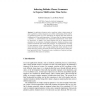Free Online Productivity Tools
i2Speak
i2Symbol
i2OCR
iTex2Img
iWeb2Print
iWeb2Shot
i2Type
iPdf2Split
iPdf2Merge
i2Bopomofo
i2Arabic
i2Style
i2Image
i2PDF
iLatex2Rtf
Sci2ools
IEAAIE
2005
Springer
2005
Springer
Inferring Definite-Clause Grammars to Express Multivariate Time Series
In application domains such as medicine, where a large amount of data is gathered, a medical diagnosis and a better understanding of the underlying generating process is an aim. Recordings of temporal data often afford an interpretation of the underlying pattens. This means that for diagnosis purposes a symbolic, i.e. understandable and interpretable representation of the results for physicians, is needed. This paper proposes the use of definitive-clause grammars for the induction of temporal expressions, thereby providing a more powerful framework than context-free grammars. An implementation in Prolog of these grammars is then straightforward. The main idea lies in introducing abstraction levels, and in using unsupervised neural networks for the pattern discovery process. The results at each level are then used to induce temporal grammatical rules. The approach uses an adaptation of temporal ontological primitives often used in AI-systems.
| Added | 27 Jun 2010 |
| Updated | 27 Jun 2010 |
| Type | Conference |
| Year | 2005 |
| Where | IEAAIE |
| Authors | Gabriela Guimarães, Luís Moniz Pereira |
Comments (0)

